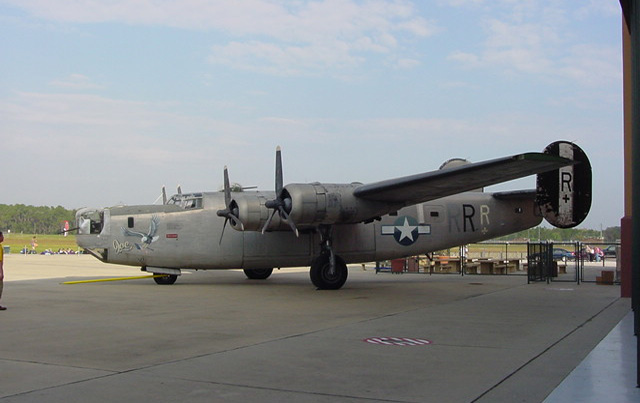
1944 Consolidated B-24J Liberator
The B-24 Liberator was designed in 1939 as a replacement for the Boeing B-17 Flying Fortress. Its roomy fuselage and high aspect ratio Davis wing enabled the B-24 to fly higher, farther, and to carry a greater bomb load than the B-17.
A total of 18,481 examples were built, making it the most widely produced U.S. military aircraft to date.
It served on all battlefronts in various roles that included bombing, mine laying, photo-reconnaissance, cargo, and transport duties. It was particularly well suited for service in the Pacific theater where its long-range capability proved of value.
This particular aircraft is one of 1,278 delivered to the RAF and Coastal Command as part of lend-lease. Known as a Liberator Mark VI in the RAF, it is believed to have been delivered in August 1944 to 215 Squadron RAF in Kolar, India, as a replacement for the Vickers Wellington bombers, which were being phased out.
If this were the case, the aircraft would have participated in the long range bombing missions the squadron made into Burma to destroy the infamous Siam-Burma railway bridges that the Japanese built at the cost of over 24,000 Allied prisoners’ lives.
Specifications
- Year Built — 1944
- Wingspan — 110′
- Cruise Speed — 215 mph
- Top Speed — 287 mph
- Gross Weight — 65,000 lbs
- Engine Type — Four Pratt & Whitney R-1830 (1200 hp)
Kermit’s Comments
After WWII, the RAF destroyed most of their lend-lease aircraft, and the newly independent government of India received some salvageable aircraft. This aircraft is one of four surplus Indian Air Force B-24 bombers acquired by collectors in the early 1970s, and I subsequently acquired it. The aircraft was flown to Fantasy of Flight in the early 1990s and will undergo a complete restoration before it flies again.
There was always a rivalry between the B-17 and the B-24 crews during World War II as to which four-engine bomber was better. While the B-24 crews would always say that their aircraft could fly faster and further, the B-17 crews would reply that their aircraft could take more punishment and the B-24 was just the box the B-17 came in.